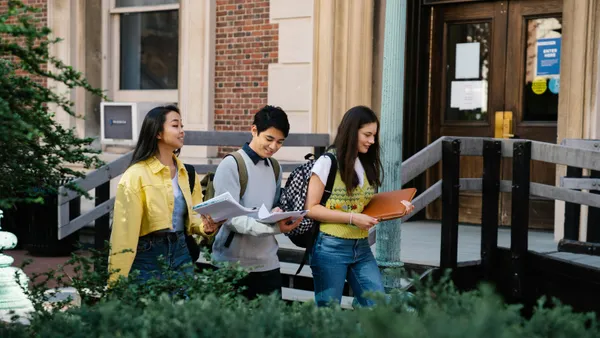Editor's note: It's harder than ever for colleges to fill their incoming classes, but some schools are meeting that challenge with creativity. In this regular column, called The Pipeline, we'll spotlight innovative tactics colleges are using to cut through the noise and reach prospective students throughout the recruitment and enrollment process
Video-sharing platform TikTok's dance routines, lip-syncs and pranks made it a popular escape from unrelenting news about the pandemic. But the app's popularity poses a question for colleges: Should they even be on the platform?
To Daniella Nordin, director of marketing at marketing firm mStoner, the answer depends on whom you ask.
"Higher ed marketers would tell you that colleges and institutions should be on TikTok," she said. "And I think students would tell you that it is inauthentic and it's not a space for colleges and universities to be."
Colleges run the risk of trying too hard to be seen as cool or hip on TikTok, Nordin said. Still, she believes that colleges can carve out a place on the platform that helps build their brand — if they have the right strategy.
Colleges should focus on content that performs well on TikTok, such as how-to videos or those that feature visual or performing arts, she said. Some institutions appeared to have cracked the code, racking up views on videos that showcase their campus or explain steps in the enrollment process.
Syracuse University, which enrolls about 23,000 students, featured several student-produced videos over the spring term that show their day-to-day lives on the New York campus. In one, a student trudges through the cold to grab Starbucks, hits up the campus gym and even gets tested for the coronavirus.
This type of video helps viewers get a firsthand look at student life, Jonah Restuccio, Syracuse's manager of social media strategy, said in an email.
And the platform has also helped the university reach prospective students during the pandemic. "With students not able to visit campus and longing for what life really looked like on campus, TikTok was huge for us in communicating that vision," Restuccio said.
The university's social media team is also made up of a student intern and six student ambassadors who aim to create content that resonates with its target audience.
Although colleges may reach prospective students with TikTok content, Nordin sees the platform more as a way to build brand awareness than as a recruiting opportunity.
Admission officers have often overestimated the extent to which teens parse colleges' official social media accounts during the application and enrollment process, according to a 2015 survey from Chegg Enrollment Services and mStoner. Although the survey predated TikTok's rise in the U.S., it also found most students never or rarely use social media platforms such as Twitter, Instagram or Snapchat for college research.
Still, TikTok offers an opportunity to reach thousands of viewers.
One video from Syracuse, which had more than 100,000 views, shows shots of the campus to a remix of Jefferson Airplane's "Somebody to Love." Another one of its viral videos pokes fun at the university's at-times frigid climate.
And it could provide a way to help students through the admissions process. Austin Peay State University, a Tennessee institution that enrolls around 11,000 students, has uploaded videos explaining the steps students need to take to enroll or reminding them of admissions deadlines.
The videos often feature student tour guides or ambassadors. Officials running the account hope that if a student follows the Austin Peay TikTok account and then comes to campus for orientation, they will immediately recognize some of the people in the clips.
"We want that connection to be built early," said Alejandro Herrera, associate director of admissions.
The college also takes steps to make sure their content is relevant to a younger audience by showing their videos to current students before uploading them to the platform.
"If they don't understand it here," Herrera said, "why would we put out the content?"














